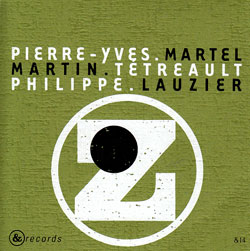
Musicians who let drones do most of the talking for them might learn a thing a two from Martel, Tetrault, and Lauzier. Complex drone washes can be beautiful in themselves, to be sure. But developments in the shape of the sound — the "composition," for lack of a better term — in drone musics can be glacial at best. The listener can ironically feel almost coerced to enter that hypnotic state that best lends itself to enjoying steady drones.
The pieces on La formule XYZ perhaps highlight a strategic element that may seem missing when you are in the mood for something more engaging: the use of figure/ground contrasts. What do I mean by this? Listen to track one "x=(R)z," for example. A sound complex is established at the beginning of the piece and it is held pretty much static throughout, making it function as a drone. At the beginning, this drone is the "figure," the main voice of the piece. However, as the piece advances, other sound events and sound complexes occur "on top of" this drone. As they happen, they momentarily become figure, and the static elements serve as ground. Later, though, the original drone also returns as figure occasionally, as the other sound events stop or otherwise lose our attention. Through this use of figural interplay, the drones tend to retain their effectiveness and attraction as musical events. Their ability to capture our interest is continually recycled and renewed.
Mind you, this is noisy stuff. Consider the instrumentation:
Yves Martel: feedback, static
Martin Tetrault: pickup, pick-up, equalizer
Philippe Lauzier: soprano saxophone, bass clarinet, prepared amplifier
This should give readers some indication of the sense of the term "drones" used above. The tones and timbres here can be quite saw-toothed. This is post-industrial music, to be sure. Yet, on the harshness continuum, the aesthetic is much closer to your Nakamuras than your Merzbows.
Aside from this group's effectiveness as an ensemble, it really should be noted how well they work as an electroacoustic ensemble specifically. Track four (sparing you its Braxtonian title) is a great example. While Lauzier uses a purely acoustic instrument, soprano saxophone, the piece retains the machine-like aesthetic of the more electronically voiced tracks. Part of this is surely due to Lauzier's playing (and his magnificent amplified bass clarinet on track six is a stand-out aspect of this recording). But it is also testament to the solid studio skills of those involved in making this disk: the balance of the three musicians is perfect throughout. The mix is upfront with minimal processing, providing a level of detail that suits this trio best.
Comments and Feedback:
|



